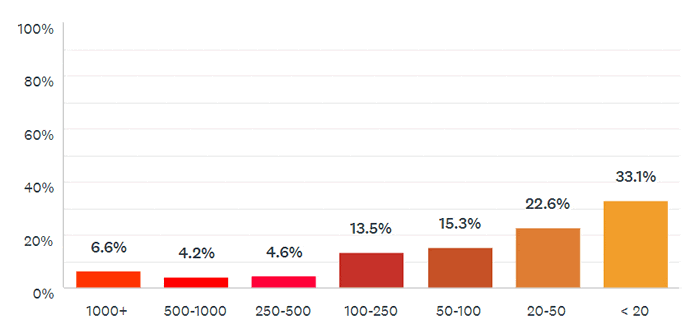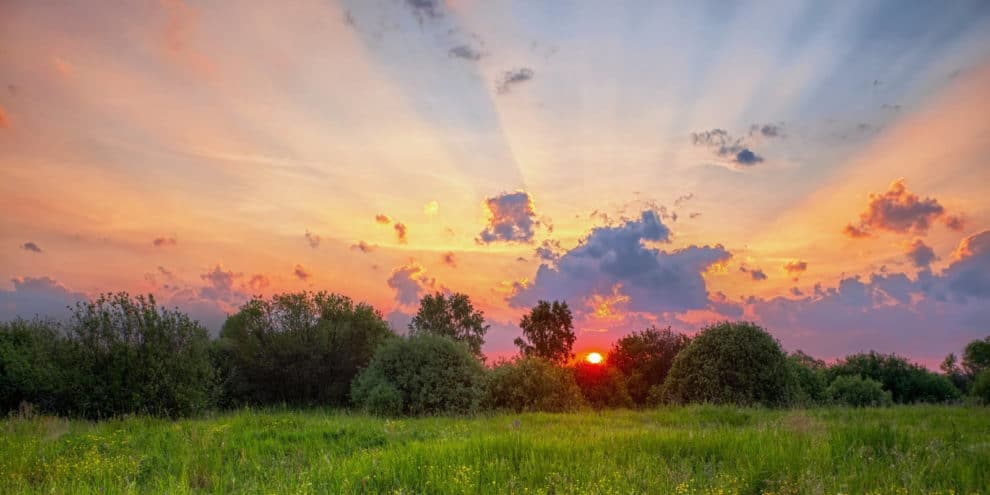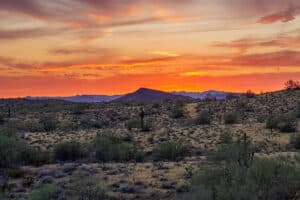According to the LANDTHINK Pulse results, 33.1% of our audience indicated that if they were looking to buy land within the next year, they would be in the market for less than 20 acres. There are many factors that go into the decision to buy land, but one of the first concerns to buyers is the number of acres they should buy. There is no right answer; it all depends on a buyers’ budget, their specific situation and needs, and why they want to purchase the land.
Last month, the September Pulse asked: If looking to buy land within the next year, how many acres would you be in the market for?
September Pulse Sponsored by
Escaping densely populated areas around fear of the coronavirus and civil unrest has been the primary motivation for purchasing land for sale this year. Many buyers don’t have a specific plan for the land they are buying other than seclusion, so the amount of land they should search for largely depends on their budget and preference. Some buyers are looking to build a home, others want to establish a mini farm, where they can live comfortably and self-sufficiently, and some buyers desire a prime spot for hunting and other recreational activities. Most of these purposes can be accomplished on less than 20 acres of land. LOTFLIP, part of the LANDFLIP NETWORK, caters to the large segment of buyers and investors searching for land for sale under 20 acres, and also features lot auctions, lots for lease, and foreclosed lots.
It’s no surprise that people are downsizing the American dream of land ownership. In uncertain economic times, people are wary of jumping in and making a large investment. More people can afford 20 acres, where more than 20 acres is sometimes out of their comfort zone. Cost is a significant driver of the trend toward smaller tracts. Smaller tracts mean smaller loan payments and property taxes, lower development costs, and reduced spending on upkeep.
If a buyer is planning on building a home, they won’t need nearly as much land as they would if they were planning to start a farming operation or plant timber for future income generation. With a smaller number of acres (10-20), it is possible to grow a garden and raise smaller herds and flocks. Small acreage farms present big opportunity, but they are not feasible for farming at a commercial level. Large scale commercial farming operations require hundreds of acres of farmland. If the plan is to raise livestock, buyers will need to purchase enough land that can support the herd or flock they may eventually have- with plenty of space for grazing.

Coming in second, 22.6% of respondents indicated that if they were looking to buy land within the next year, they would be in the market for 20-50 acres.
Some intended uses for land require larger tracts. Prospective buyers who want to purchase recreational land with some kind of a cash-flow component such as timberland, need to consider larger quality tracts of land they can hold on to while their investment grows. “Quality” meaning land in a desirable location with growth potential, is accessible, can be used as a single family homesite, or utilized for outdoor recreational pursuits. In order to generate income from periodic timber harvests, most land agents recommend that at least 35-40 acres of the total acreage be “timbered” acres- generating enough volume to be able to sell the harvest to a timber buyer at prices that ensure the enterprise profitable.
If you’re scouting out land for hunting, most land agents recommend at least 50 acres for hunting deer with a rifle. How much acreage that’s needed for hunting varies, depending on the wildlife you plan to hunt, your style of hunting, and how many hunters will be on the property on with you. It’s a common misconception that bigger is better for giving up bucks- hunters used to believe they needed 1,000 acres to ever find a deer or turkey. Bow hunting can be successful on about 10 acres, and bird hunting can be done on a .5 acre open field with a combination of woods plus a water source.
In an article published on LANDTHINK, How Do You Decide How Much Land to Buy?, PotlatchDeltic offered this piece of advice. “For many buyers, a smaller tract of land that’s at least 40 acres (an acre is roughly the size of a football field) is good for recreation. But for those who want more privacy, a variety of hunting opportunities, and timber, a larger tract may be a better fit. Resist the temptation to look at the sales price in a vacuum – after all, you get what you pay for. Paying more for a property with quality timber, proximity to recreation, and good roads may well be worth the extra cost.”
It’s important to work closely with a land broker that has the knowledge and experience to help you make a wise decision on how much rural land for sale you will need to purchase in order to accomplish your goals.
The LANDTHINK audience expressed mixed opinions on how many acres they would be in the market for over the coming year. The results of our informal online survey were all over the board, but the largest percentage (33.1%) indicated that their interest would lie in less than 20 acres, followed closely by 22.6% who said that they were likely to purchase 20-50 acres. This was followed closely by 15.3% who said that they would be interested in buying 50-100 acres. Only 13.5% said 100-250 acres, 6.6% said 1000+ acres, 4.6% said 250-500, and just 4.2% said they would be in the market for 500-1000 acres.
Thank you to everyone who participated and shared the Pulse with friends and connections in the land industry. LANDTHINK would like to thank LANDFLIP for sponsoring the September Pulse. LANDFLIP helps buyers easily find land and provides land sellers with an easy to use platform for marketing and advertising land for sale, land auctions, land for lease, and land for sale by owner.
Become a Pulse sponsor! It’s a great way to ensure your brokerage is the first one buyers and sellers call when they have a need to buy or sell property. You’ll get insane exposure on Social + Email + Web. That’s 500,000+ monthly eyes on you! Once you have it, you won’t want to give it up! Pulse sponsorships are offered on a first come first serve basis and are subject to certain limitations. If your business is interested in becoming a Pulse sponsor, or if you have a suggestion for next month’s Pulse question, please contact us.
We want to know what you think about our October Pulse question, chosen and sponsored by Southeastern Land Group: When you request more information about an online land listing, how would you prefer the agent provide it to you? Answer now.
This content may not be used or reproduced in any manner whatsoever, in part or in whole, without written permission of LANDTHINK. Use of this content without permission is a violation of federal copyright law. The articles, posts, comments, opinions and information provided by LANDTHINK are for informational and research purposes only and DOES NOT substitute or coincide with the advice of an attorney, accountant, real estate broker or any other licensed real estate professional. LANDTHINK strongly advises visitors and readers to seek their own professional guidance and advice related to buying, investing in or selling real estate.











Add Comment